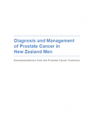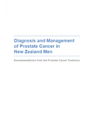Prostate cancer is a significant burden to men’s health and is now one of the most important issues facing New Zealand men.The lack of a reliable way of detecting prostate cancer early has created many challenges. The commonly used prostate specific antigen (PSA) blood test detects both cancer and non-cancerous conditions. As well, some prostate cancers are slow growing and may not affect a man’s quality of life or cause early death.
The Health Select Committee recommended that the Ministry of Health establish a prostate cancer quality improvement programme to raise awareness and understanding of prostate cancer and ensure all men have fair access to quality information and care.
The Prostate Cancer Taskforce (the Taskforce), a group of clinical experts, was established in 2012 to agree recommendations for the Prostate Cancer Awareness and Quality Improvement Programme.Its recommendations are detailed in this report.
The Taskforce recommends providing men and their families and whānau with easily understood information about the prostate, prostate cancer and symptoms.It emphasises the central role of the general practitioner in screening, assessing and supporting men for prostate cancer. Their role may include monitoring men under watchful waiting or active surveillance and the management of metastatic disease and palliative care.
The Taskforce also reviewed indications for referral for specialist management. Specialist management includes further clinical assessment, which may lead to men undergoing prostate biopsy and relies on accurate prostate cancer grading by the pathologist.
Treatment options include active surveillance and curative treatment using surgery or radiation therapy. Other considerations that the Taskforce has addressed are palliative care and access to health services.


